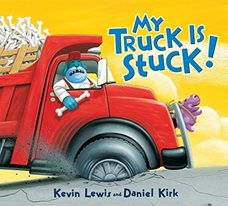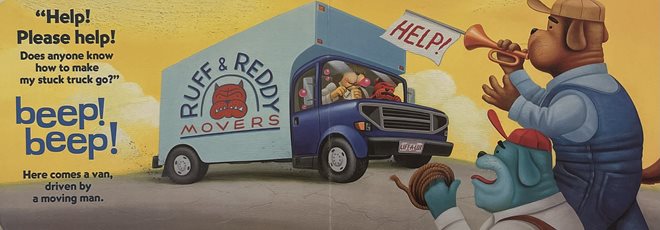This month’s Book Nook topic is...
Building Print Knowledge with My Truck Is Stuck


By Kevin Lewis and Daniel Kirk
|
When you read a book with a child, chances are they’re focused on the colourful illustrations on the page, as well as on your voice as you tell the story. They may not notice the words on the page or realize that the written words play an important role in telling the story.
One of the most important early literacy skills you can help a child learn is print knowledge. This skill begins with the understanding that print has meaning – that it communicates a message or tells a story just like spoken language does. Print knowledge also includes understanding the “rules” about reading print (for example, that we read from left to right), as well as understanding that letters make up words and spaces separate words.
There’s a lot you can do during book reading to build children’s print knowledge. Let’s get started!
|
Why we chose this book
My Truck Is Stuck is a fun book about a dump truck whose wheel gets stuck in a hole in the road made by a group of mischievous gophers. While the dog driving the truck is busy getting help from others, the gophers manage to steal all of the bones in the back of his truck!
A lot of the print in this book stands out to emphasize the excitement (and desperation!) in the driver’s voice as he calls for help. Large, colourful words make it easy to draw children’s attention to the print, and also to point out symbols that add to the print’s meaning, like exclamation marks and quotation marks.
Make Print Pop!
Building children’s print knowledge starts with drawing their attention to it – making it pop! The Hanen strategy POP stands for Point Out Print. The more you Point Out Print during book reading, the more you raise the child’s awareness of it, which encourages them to think about it and start to make comments or ask questions about it. This helps to prepare them for reading and writing on their own when they’re ready.
Here are a few ways you can POP with My Truck Is Stuck:
Track the words as you read
The first time you read a book with your child, it’s all about discovering the story and understanding how the events unfold. You don’t want to interrupt the reading at this point with too many questions or comments. But one subtle thing you can do to point out print is to run your finger under the words as you read them. This helps the child make the connection that what you’re saying is also what’s written on the page. Before you start the book, you might also point at the title and make a comment like, “Ok, I’m going to start by reading these words here, which tell me the title of the book. It’s called My Truck Is Stuck”.
Point out emphasized words
Once the child is familiar with the story, you can pause a few times during the reading to talk about print. In My Truck Is Stuck, the words “Help! Please Help!” and “Beep! Beep!” appear larger and more colourful than the rest of the text, making it easy to draw the child’s attention to it. You can point to the words and say, “These words say, ‘Beep! Beep!'. Look how big the words are. Do you think we should read them quietly or loudly?”

Point out symbols that add meaning to print
My Truck Is Stuck is full of punctuation marks like exclamation and question marks, as well as quotation marks. You can draw the child’s attention to a few of these symbols to help them understand that they have meaning. For example:
- Point to the quotation marks and explain, “These marks around the word mean that someone is talking.” Then run your finger under the words as you say, “It’s the dump truck driver that’s saying, ‘Rotten luck. Can’t go. My truck is stuck.’”
- After the driver says, “Help! Please Help!”, point to the exclamation mark and say, “This mark here is called an exclamation mark. It tells me to say the word more loudly. I think the driver must be worried and he’s calling very loudly for help.”
Point out words in signs
The word “help” appears in many creative ways throughout the book, including on signs and even as a jet cloud in the sky. You can point these words out to help the child understand that words can be written to send messages to people. You could say, “Look, even the jet plane is helping by writing the word ‘Help’ in the sky.” You could follow your comment with a question like, “What do you think will happen now that they put the word ‘help!’ up in the sky?”
z
POP Beyond the Book
One of the great things about the POP strategy is that you don’t need to stop when the book is over! You can POP in many different situations – for example, by pointing out print on cereal boxes, clothing, and signs outside. Try pointing out something related to what you talked about in the book. For example, when looking at a cereal box, you could say, “This word says ‘New!’ It has an exclamation mark after it just like the marks we saw in My Truck Is Stuck. Why do you think there’s an exclamation mark here?”
The more you POP with children, the more opportunities they’ll have to explore and build an interest in print. Helping them recognize that print is meaningful builds the foundation for later reading and writing.
Happy reading!
More resources
The strategies in this Book Nook post are drawn from Hanen’s practical, research-based guidebooks for building emergent literacy. Explore the links below to learn more about how these guidebooks can support you.
We’ll let you know when a new Book Nook topic
has been posted!
Return to Book Nook